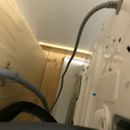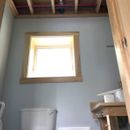Washer leak: concern about wall moisture.
Our combo washer/dryer is in an open area on our second floor along the north wall. We have a pan underneath it to catch spills, but the pan isn’t plumbed to a waste line. We had a water leak (human error) yesterday afternoon. We caught it fairly quickly, but water did fill the pan and start to flow over onto the 2×6 t&g spruce floor. I think the t&g spruce funneled the majority of the water down to the first floor half bath, the room directly under the machine. Water was pouring down all walls of the half bath. My best guess is that 2-5 gallons of water was spilled, I think we got quite a bit of it via towels and vacuum.
We ripped out the half bath ceiling drywall (which was wet and had some pooled water near the bath fan), I didn’t mind this because it exposes the 2×12 hemlock joists, we’ll do something else to trim this ceiling as it doesn’t need to be drywall. The weather is humid so we’re running a dehumidifier, mini split on dry mode, and some fans to dry things out. There’s certainly no more visual evidence of water and I think any exposed wood is drying out, if not already dry.
My concern is water that may have gotten into the drywall and/or insulation on the north wall. It may not be much at all or some parts of the framing/insulation could be damp. Our wall from inside to out is painted drywall, staggered 2×4 12″ double stud with dense pack cellulose, taped Advantech sheathing, Typar, vented 3/8″ rain screen, Spruce clapboards. The bottom of the exterior wall does have a 8″ PVC water table board with ice&water shield underneath, which probably blocks exterior drying.
For those of you with experience with leaks like this or good knowledge of how well walls dry out, do you think:
a) just keep drying things out, you should be ok
or
b) rip out the north wall drywall and evaluate the framing/insulation (which we of course don’t want to do)
Thanks for reading and any advice,
Brian
GBA Detail Library
A collection of one thousand construction details organized by climate and house part











Replies
Brian,
I don't think you need to rip out all of the drywall on your north wall. But if I were you, I would make a 4 inch by 4 inch inspection hole right above the baseboard, in the area of the wall where water entry is most likely. Feel the cellulose with your fingers, and then make a decision on what to do next based on what you discover.